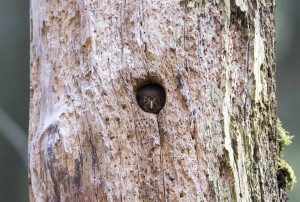 A hike in the highlands around the Brocken, the highest mountain far and wide. It’s foggy and windless. It also snowed for a few days. Then suddenly a rhythmic song, a scale, can be heard. It is a Eurasian Pygmy Owl (Glaucidium passerinum), which sits a little later on a dead, thickly icy spruce tree above a large block field. When the bird notices me, it flies into a snow-covered young stand of Spruce (Picea abies).
A hike in the highlands around the Brocken, the highest mountain far and wide. It’s foggy and windless. It also snowed for a few days. Then suddenly a rhythmic song, a scale, can be heard. It is a Eurasian Pygmy Owl (Glaucidium passerinum), which sits a little later on a dead, thickly icy spruce tree above a large block field. When the bird notices me, it flies into a snow-covered young stand of Spruce (Picea abies).
Natural Spruce forests with lots of old and dead wood are the habitat of the rare Pygmy Owl. The starling owl weighs no more than a Eurasian Blackbird (Turdus merula). This species of owl, which had not been recorded in the Harz Mountains for a long time, only resettled itself again at the end of the 1980s, after their traditional habitat had developed back to being more natural.
Due to the state of the landscape in the first half of the 19th century, the Harz Mountains did not offer sufficient, favorable habitats for the Pygmy Owl. The few observations in north-west Germany are distributed over records mainly in the years 1954, 1955, 1962, 1963, 1971 and 1976, 1977. These years coincide with invasion years from Scandinavia, which have extended to Denmark. Apparently, these little owls also reached north-west Germany.
Today there is again enough standing dead wood and spruces with woodpecker holes (Dendrocopos major) as nesting trees not only in the Harz Mountains, and here in particular in the National Park, as well as sufficient food in terms of small birds and mice. The owl uses the burrows of the Great Spotted Woodpecker in old spruce trees particularly often for its brood. The pygmy owl needs these for its nest and for its pantries. Typical songbird species of the mountain spruce forests, which are regularly recorded as prey, are the Crested Tit (Lophophanes cristatus) with its frequent trill and the Coal Tit (Periparus ater).
To meet the growing demand for top-of-the-line images of the rarer Palaearctic species, Bird-lens.com strives to expand the range of images of Western Palaearctic birds. Keeping the eyes open in the immediate vicinity is often crowned with beautiful impressions and some rare observations. The blog’s nice picture is just a first impression, which you can find in the gallery in the “Picture Shop” very soon. Please leave a message if bird-lens.com can provide a picture or more.